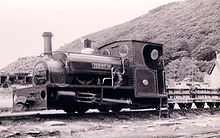Quarry Hunslet

The term Quarry Hunslet ( Quarry Hunslet ) describes narrow-gauge and relatively small steam locomotives built by Hunslet for operation in quarries . The term coined by British railway enthusiasts is not precisely defined and, depending on your point of view, only includes quarries in North Wales or even only the local slate quarries in which these locomotives first appeared.
Quarry Hunslets were built between 1870 and 1932; most of them were used in the Penrhyn and Dinorwic quarries , which were then among the largest in the world. The use of these locomotives did not end until the 1950s and 1960s, which is why a comparatively large number of Quarry Hunslets have been preserved.
Areas of application
The smaller locomotives in particular were used directly in the quarries, often in galleries that could only be reached via inclined lifts. Other locomotives were used to transport the extracted material to the quarry's own ports or for shunting within these ports.
The area of application of the vehicles is partly evident from the class names; so called z. B. the "Mills Class" locomotives, which were used for the traffic between the mills (mills) called workshops, in which the slate was processed, and the reloading station for onward transport.
features
All Quarry Hunslets are running-axle-less wet steam tank locomotives with two coupled axles ( type B n2t). The saddle tank and the short wheelbase are characteristic of the appearance of the locomotives, whereby the standing tank is arranged behind the second coupling axle and, like the smoke chamber, is raised compared to the long tank - which in turn is concealed by the saddle tank.
Based on the typical shape of the saddle tank with a flattened top and vertical side walls, on which the name tags are always attached, the Quarry Hunslets can be easily distinguished from comparable machines from other manufacturers.
Other features found in most cases are a slightly under 2 foot gauge (mostly 578 or 597 mm), an outer frame, slightly inclined outer cylinders and an internal Stephenson control . On the locomotives with a 3 foot (914 mm) track gauge, of which no copy has survived, the wheels were outside the frame ; however, the other differences were minor.
Classification
Although the greater part of the Quarry Hunslets today is divided into classes (eg "Alice Class" or "Large Quarry Class"), this only partially applies to the actual circumstances. The class names do not come from Hunslet, but only arose around the middle of the 20th century in connection with the correspondence between railroad friends and the quarries.
The locomotives of the larger "classes" were also delivered individually or in small groups, sometimes over a period of almost 20 years. On the one hand, this resulted in minor differences within a class, on the other hand, locomotives delivered for different quarries but largely identical in construction were divided into different classes. The “Alice Class” machines of the Dinorwic quarry differ from each other more than the Britomart locomotive, which does not belong to this class (because it was delivered to a different quarry), from newer examples of the Alice Class.
A classification that disregards the operators is possible based on the main dimensions of the locomotives, in particular the wheelbase and cylinder dimensions. Another distinguishing feature is the design of the driver's cab : in the majority of locomotives, the cab floor is at the same level as the circulation; with some, however, it is slightly lowered compared to the perimeter (“stepped frame”) in order to make it easier to get in or so that the driver's cab does not exceed a certain overall height.
Whether or not there is a driver's cab, on the other hand, does not play a role in the division into classes; this only depended on the operating environment and could change over time for a given locomotive. The same goes for the length of the chimneys.
Overview
Sorted according to wheel base, wheel diameter and cylinder dimensions in ascending order, the following classification results:
| Wheel base (mm / inch) |
Wheel diameter (mm / inch) |
Cylinder diameter (mm / inch) |
Cylinder stroke (mm / inch) |
Locomotives / classes | annotation |
|---|---|---|---|---|---|
| 914/36 | 457/18 | 127/5 | 203/8 | Louisa | no circulation |
| 914/36 | 470 / 18.5 | 152/6 | 203/8 | Silurian | no circulation |
| 991/39 | 508/20 | 178/7 | 254/10 | Alice Class, Small Quarry Class, etc. a. | Boiler mostly without a steam dome |
| 991/39 | 508/20 | 178/7 | 254/10 | Tryfan and Cadfan | particularly low-built "tunnel locomotives" |
| 991/39 | 508/20 | 178/7 | 254/10 | Dinorwic Port Class | Boiler position higher than Alice Class, boiler with steam dome |
| 991/39 | 508/20 | 178/7 | 254/10 | Hughie, Stephen, Singapore, Donald and Ardwhallin | for 3-foot track with inner frame |
| 1219/48 | 508/20 | 178/7 | 254/10 | Penrhyn Port Class u. a. | stepped frame |
| 1219/48 | 508/20 | 191 / 7.5 | 254/10 | Large Quarry Class | |
| 1219/48 | 610/24 | 165 / 6.5 | 254/10 | tiger | for 3-foot track with stepped inner frame and inner cylinders |
| 1295/51 | 610/24 | 191 / 7.5 | 356/14 | Dinorwic and George | horizontal cylinders |
| 1372/54 | 660/26 | 216 / 8.5 | 356/14 | Lilla | |
| 1372/54 | 660/26 | 216 / 8.5 | 356/14 | Mills Class | stepped frame |
| 1524/60 | 660/26 | 254/10, 267/10.5 | 305/12 | Charles, Linda and Blanche | strongly inclined cylinders, no rotation |
literature
- Cliff S. Thomas: Quarry Hunslets of North Wales. The great (little) survivors . Oakwood Press, Usk 2004, ISBN 0-85361-575-6 , ( Oakwood Press series X71).
Web links
- The Quarry Hunslet Web Site (English)
